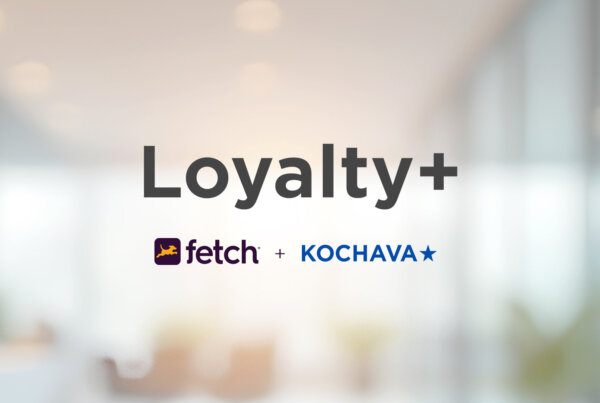Our favorite CEO was featured on Appia’s Ask the Expert Series this week. You can view the original article here.
Kochava offers a unique, holistic and unbiased approach to mobile attribution analytics and optimization. Via its platform, Kochava provides mobile advertisers with precise, real-time visualization of campaign data that spans from initial launch through conversion and lifetime value (LTV) reporting, including comprehensive post-install event tracking. Kochava’s toolset enables customers to turn their data into actionable intelligence. Integrated with more than 700 publishers, Kochava is trusted by hundreds of brands including the biggest names in mobile gaming, news and media, and commerce. For more information visit www.kochava.com.
About Charles Manning, CEO of Kochava
Charles Manning is the founder and CEO of Kochava, the leading mobile attribution analytics platform serving tier-one advertisers world-wide. For nearly 20 years Charles Manning has been creating technologies that use data for system optimization, ranging from business service management (BSM) to information technology (IT) to attribution analytics. Charles began his career at Oracle, and later held executive and C-Level positions at M-Code, Managed Objects, and PLAYXPERT.
Prior to founding Kochava, Charles founded PLAYXPERT – which started as a gaming technology platform. After licensing the PLAYXPERT technology to Razer, Charles built a team that focused its time on building engagement platforms for entrepreneurs and agencies. Realizing that there were no standard platforms that provided attribution or post-install analytics in mobile that were any good – Charles and his team built one, and Kochava was born. The Kochava technology is now integrated with more than 700 publishers and is trusted by hundreds of brands including the biggest names in mobile gaming, news and media, and consumer goods.
Appia: What role do you see analytics and attribution playing in today’s mobile marketing mix?
Charles Manning: Analytics and attribution have always played an important role in marketing decisions, but with mobile, for the first time, the industry is positioned to provide a completely trackable framework that offers advertisers unprecedented visibility into the effectiveness of their ad spend. Attribution makes it very clear which campaigns are driving the most value in terms of volume of users and the value of those users. Essentially attribution takes the confusion out of the market by allowing the advertiser to define the most important drivers of quality users and enabling them to pinpoint what’s working and what isn’t.
Analytics can drill down into campaigns and provide insight into and visualization of users, sessions, countries, device versions, platform versions, app versions and other important metrics. In cases where no device identifiers are provided by a publisher or network, the Kochava platform automatically engages its probabilistic attribution (see iOS 14+ restrictions) algorithms to accurately attribute those end users without the device ID. With clear and easy-to-visualize attribution data from Kochava, double billing is eliminated, no-hassle integration is made possible across every media partner an advertiser chooses to work with and advertisers can easily determine the real value of end users and where they are coming from. At the end of the day, analytics and attribution have become the brain of the marketing mix, informing decisions and driving incredible efficiencies.
Appia: Do you think that role will change over the next twelve months?
Charles Manning: As web traffic continues to shift toward mobile, the role of attribution and analytics will only grow in importance. The MMA just published a research report stating the global mobile ad spend could reach as high as $220 Billion annually and the current allocation to mobile by marketers is disproportionately low. The report went on to state that if marketers were to adjust their mix to align with the current patterns of marketing ROI and media consumption, marketers allocations to mobile would rise dramatically. In fact, early indications suggest that the optimized level of media spend should increase by 4-7x compared to current levels in the marketplace. As brands increase the amount of mobile spend in their marketing mix, the pressure to be able to show ROI grows, and with it, the need for analytics and attribution technology skyrockets.
Appia: What do you believe is the single largest challenge for mobile advertisers today?
Charles Manning: Marketers were already faced with so many options when it comes to spending their marketing budget, and with the addition of the mobile platform those options have exploded. Add an overwhelming number of C-suite demand that you be able to show ROI on the marketing spend, and there’s your top challenge. The industry moves at the speed of light and marketers need all the tools available to keep on top of the constant changes. Companies that “get” mobile are using analytics and attribution to inform their decisions and take educated action based on real data that shows them what’s working. Pity the marketer who is stuck trying to make decisions and show ROI who isn’t taking advantage of the analytics tools available.
Appia: Lifetime value continues to be an ongoing KPI for mobile advertisers. What are other key performance indicators that mobile advertisers are closely watching?
Charles Manning: I think it really depends on the vertical. Defining and measuring campaigns against LTV is important for all advertisers. Typically aRPU and RPI by cohort are relatively important across verticals as well but then particular verticals are interested in different key performance indicators (KPIs). For example, Gaming looks at welcome flow completion, registration completions, and levels achieved, travel looks at bookings, commerce analyzes conversion metrics through all levels of the checkout process, social analyzes shares and likes, and media tracks views and ratings. To further complicate things, the KPIs that are important on one app may not be as important to another app from the same company, so the advertiser needs the ability to be flexible enough to measure just the KPIs they want to track and to change those on a whim.
Customers have noted that Kochava is exceptional at providing custom event segments along with the post-install events tracked by our system which has enabled them to have deep understanding of metrics about the business aligned with the campaigns driving the business results. For example, commerce customers can track actual SKU’s purchased with item purchase events and travel customers can track actual flight origination/termination data along with travel purchase events. This understanding helps breath clarity into the value of media spend in a language that makes sense to the business.
Appia: The holidays are quickly approaching, what trends have you seen in holidays past? Do you think they will be the same or will the climate change a bit?
Charles Manning: For one, advertiser spend picks up tremendously. That trend starts very soon and continues to build throughout the season. The volume we experience is driven by expansion with existing clients as well new clients coming into the space. Last year during Christmas week, 50 million mobile devices were activated and 1.7 billion apps were downloaded.
We are expecting and gearing up for our biggest season yet.
Appia: How critical is analytics in buying users with higher lifetime value at scale?
Charles Manning: Without analytics you can’t even define the LTV of a user, let alone optimize your buy. We have found that while LTV is a commonly-used term, the specific criteria by which it is defined can vary widely between advertisers. Whatever the definition, analytics data is crucial to understanding how to define LTV. Once you define LTV based on your goals you can easily scale your buy according to your acceptable parameters. The most effective way of scaling is to define different LTVs for different types cohorts and then go find as many users as possible against those varying targets. If you don’t have the analytics to guide you down this path then you are really just guessing at what you think is working, and that definitely doesn’t scale.
Appia: What do you see the role of programmatic and RTB playing in today’s mobile ad market? What about the future of programmatic buying for user acquisition?
Charles Manning: There is no question that programmatic and RTB will continue to be more and more important and continue to grow, especially when buying at scale. The most important factor for that growth will be transparency. Advertisers will always have a mistrust in “black boxes” because they want to understand where their ad dollars are going. But as the ecosystem continues to grow, the necessity to find the right buyers at the right time with the right content is paramount for success. The players that can deliver that, and deliver it with the transparency of understanding will be the winner.
Appia: Optimization means different things to different people. For the UA Manager, optimization may span from creative testing to lifecycle messaging. Where do you think a UA Manager with limited time would gain the most value in beginning their optimization strategy?
Charles Manning: For one, optimization can be defined against whatever goal is important to you. For a UA Manager they would obviously be optimizing against acquiring new customers. I think you’re defining it well and the most value will depend on the lifecycle of the app. If it is a new app, the focus should be on the audience and media, defining who is driving the most traffic. If the app is in a later lifecycle stage, then re-engagement campaigns will be important to keep your existing users active. Creative testing will always yield initial success and then level out, but it should be part of an on-going process.
Appia: Do you believe mobile marketers are using analytics to create actionable strategies for creating relevant and engaging UA programs?
Charles Manning: Absolutely. We have hundreds of advertisers that have teams of UA experts with their hands constantly on the levers of our analytics to drive real-time decisions day in and day out.
Appia: How do you see the UA Manager role changing over the next 2-3 years?
Charles Manning: I think the tools at their disposal will continue to evolve and grow and they will be making decisions based on very specific and granular data. The UA Manager of the future is going to be adept at using analytics toolsets, like Kochava’s, so gone will be the days of throwing a whole bunch of concepts out and hoping one of them sticks.
It will also mean increased effectiveness with less energy. I can anecdotally say that we expect Kochava 3.0, which will be released very soon, to allow our advertisers to spend 25% less time doing what they do now. This means they can either spend more time on other responsibilities (for those who handle UA on the side of another role) or increase their UA results without any additional effort on their part. Obviously, we are very excited about this and think this is crucial to enabling the UA Manager to get more creative with their strategy and execute it more efficiently. I also expect they will be making decisions on ever-increasing volumes of data. An analytics toolset that can create actionable intelligence out of this data will be at the forefront of all those decisions.
Appia: Mobile evolves quickly, what do you see on the horizon?
Charles Manning: I think there are two parts to this. We’ll continue to see maturation in the current paradigm and ecosystem but there will be lots more innovation as well. As we’ve already discussed, programmatic buying will continue to grow and ultimately end up in the forefront. I don’t think mobile payment has been nailed yet, but when players like Apple that already have mindshare and consumer trust working for them, we’ll start to see broader consumer adoption.
In terms of innovation, I don’t want to give away too much, but I can say that consolidation whether through M&A or integration partnerships, will yield exponentially more powerful toolsets for advertisers and publishers. We believe that our role is to provide the best tools and the most flexibility to empower our customers to optimize and shift their UA strategy quickly and efficiently. I am extremely impressed by how valuable the collaboration with our customers has been when it comes to innovating. They are in the trenches every day and the competition for users is intense. When our advertisers see the opportunity to get an edge, we pay a lot of attention.





